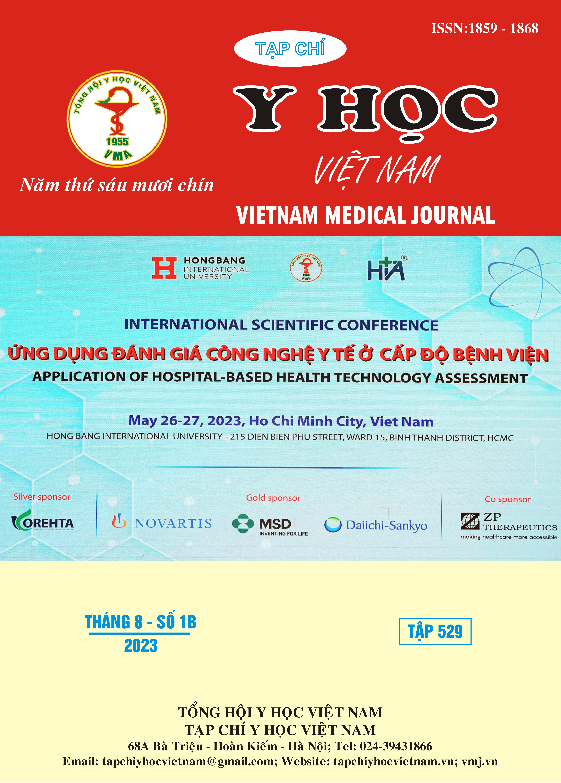ĐÁNH GIÁ KẾT QUẢ ĐIỀU TRỊ SUY GIÃN TĨNH MẠCH NÔNG CHI DƯỚI BẰNG LASER PHỐI HỢP THỦ THUẬT MULLER
Nội dung chính của bài viết
Tóm tắt
Mục tiêu: Hậu quả suy giãn tĩnh mạch nông chi dưới ảnh hưởng nhiều đến chất lượng cuộc sống của người bệnh. Mục tiêu nghiên cứu nhằm mô tả đặc điểm lâm sàng và siêu âm suy giãn tĩnh mạch nông chi dưới có chỉ định điều trị Laser phối hợp với thủ thuật Muller. Đánh giá kết quả của phương pháp Laser phối hợp với thủ thuật Muller. Đối tượng và phương pháp nghiên cứu: Nghiên cứu mô tả cắt ngang tiến cứu và hồi cứu không đối chứng trên 49 người bệnh (NB) suy giãn hệ TM nông chi dưới được điều trị bằng laser phối hợp thủ thuật Muller tại Trung tâm Chẩn đoán hình ảnh (CĐHA) và Can thiệp điện quang (CTĐQ) bệnh viện Đại học Y Hà Nội từ 3/2021 đến 3/2023. Kết quả: Tuổi trung bình mắc bệnh 56,31 ± 12,63, tỷ lệ nữ/nam là 2,5. Triệu chứng lâm sàng búi giãn tĩnh mạch và đau nặng chân với tỷ lệ lần lượt là 93,33% và 90%. Giai đoạn lâm sàng theo CEAP thường gặp chiếm tỉ lệ cao nhất là C2 chiếm 61,67%. Điểm VCSS trước điều trị 6,02 ± 1,47. Trước can thiệp, đường kính và dòng trào ngược TMHL lần lượt là 6,97 ± 1,63mm, 3,56 ± 1,42s. Đường kính tĩnh mạch giãn dưới da vùng cẳng chân điều trị bằng thủ thuật Muller là 3,87 ± 0,8mm. Hiệu quả tắc mạch 100% sau can thiệp; triệu chứng và giai đoạn lâm sàng theo CEAP, điểm VSCC, đường kính tĩnh mạch giảm rõ rệt so với trước can thiệp. Thủ thuật an toàn với tỷ lệ biến chứng thủ thuật tại thời điểm ngay sau can thiệp, sau 1 tháng, 3 tháng và 6 tháng thấp, không gặp biến chứng nặng. Kết luận: Phương pháp laser nội tĩnh mạch kết hợp với thủ thuật Muller trong điều trị SGTMNCD là phương pháp ít xâm lấn, tỉ lệ thành công cao với hiệu quả tắc mạch 100%, không tái phát sau theo dõi 6 tháng, giảm triệu chứng trên lâm sàng và trên siêu âm Doppler. Tỷ lệ biến chứng ngay sau can thiệp thấp, thời điểm 1 tháng, 3 tháng và 6 tháng không ghi nhận biến chứng
Chi tiết bài viết
Từ khóa
: suy giãn tĩnh mạch chi dưới, can thiệp laser nội mạch, Muller.
Tài liệu tham khảo
2. Lê NM và cs. (2022). Bước đầu đánh giá hiệu quả điều trị suy tĩnh mạch mạn tính bằng phương pháp đốt laser nội mạch. Vietnam J Radiol Nucl Med;(31):36-42.
3. Nguyễn Thị Cẩm Vân và cs. (2021). Kết quả điều trị suy giãn tĩnh mạch nông chi dưới bằng phương pháp đốt sóng cao tần tại Bệnh viện Trung ương Huế. Tạp Chí Y Học Lâm Sàng; (68):48-53.
4. Myers K et al. (2006). Treatment of varicose veins by endovenous laser therapy: assessment of results by ultrasound surveillance. Med J Aust;185(4):199-202.
5. Navarro L et al. (2001) Endovenous laser: a new minimally invasive method of treatment for varicose veins--preliminary observations using an 810nm diode laser. Dermatol Surg;27(2):117-122.
6. Muller R (1966). Traitement des varices par la phlebectomie ambulatoire. Phlebologie. 19:277-279.
7. Hamann SAS et al. (2019). Randomized clinical trial of endovenous laser ablation versus direct and indirect radiofrequency ablation for the treatment of great saphenous varicose veins. Br J Surg;106(8):998-1004.
8. Li X et al. (2019). Varicose Veins of the Lower Extremity Secondary to Tricuspid Regurgitation. Ann Vasc Surg;60:477.e1-477.e6.


